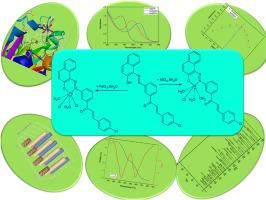偶氮查尔酮配体衍生的Fe(III)和Ni(II)配合物的合成、表征和抗菌评价:光谱、热学和分子对接研究
IF 3.4
4区 化学
Q2 CHEMISTRY, MULTIDISCIPLINARY
引用次数: 0
摘要
本研究报道了新开发的偶氮查尔酮基有机配体衍生的新型铁(III)和镍(II)金属配合物的设计、合成、结构表征和抗菌评价。利用一系列光谱和分析技术,包括红外光谱、紫外可见光谱、质子核磁共振光谱、质谱、元素分析、摩尔电导率测量和磁化率分析,对其进行了全面的结构解析。结果证实了配体通过偶氮官能团和酚官能团与金属中心的配位,并表明了这两种金属配合物的八面体几何结构。通过电导率研究证实了配合物的非电解性质,而元素分析建立了金属与配体1:1的化学计量。热分析显示了高的热稳定性,并表明存在配位水分子。生物实验显示,与游离配体相比,金属配合物的抗菌活性显著增强,其中镍(II)配合物的抗菌效果最高,尤其是对铜绿假单胞菌的抗菌效果。这种增强的生物活性归因于增加的亲脂性和改善的与微生物细胞膜的相互作用。此外,分子对接研究表明,金属配位显著提高了配合物与细菌靶蛋白的结合亲和力,其中镍(II)配合物表现出最强的结合相互作用。这些发现表明,金属络合作为一种增强生物活性配体药理学特性的策略具有潜力。本文章由计算机程序翻译,如有差异,请以英文原文为准。

Synthesis, characterization, and antimicrobial evaluation of Fe(III) and Ni(II) complexes derived from azo-chalcone ligand: Spectroscopic, thermal, and molecular docking investigations
This study reports the design, synthesis, structural characterization, and antimicrobial evaluation of novel iron(III) and nickel(II) metal complexes derived from a newly developed azo-chalcone-based organic ligand. Comprehensive structural elucidation was performed using a range of spectroscopic and analytical techniques, including infrared spectroscopy, ultraviolet–visible spectroscopy, proton nuclear magnetic resonance spectroscopy, mass spectrometry, elemental analysis, molar conductivity measurements, and magnetic susceptibility analysis. The results confirmed coordination of the ligand to the metal centers through azo and phenolic functional groups, and indicated an octahedral geometry for both metal complexes. The non-electrolytic nature of the complexes was verified by conductivity studies, while elemental analysis established a metal-to-ligand stoichiometry of 1:1. Thermal analysis demonstrated high thermal stability and suggested the presence of coordinated water molecules. Biological assays revealed significantly enhanced antimicrobial activity of the metal complexes compared to the free ligand, with the nickel(II) complex showing the highest antibacterial effectiveness, particularly against Pseudomonas aeruginosa. This enhanced bioactivity is attributed to increased lipophilicity and improved interaction with microbial cell membranes. Furthermore, molecular docking studies demonstrated that metal coordination significantly improved the binding affinity of the complexes to bacterial target proteins, with the nickel(II) complex showing the strongest binding interaction. These findings suggest the potential of metal complexation as a strategy to enhance the pharmacological properties of bioactive ligands.
求助全文
通过发布文献求助,成功后即可免费获取论文全文。
去求助
来源期刊
CiteScore
3.50
自引率
7.70%
发文量
492
审稿时长
3-8 weeks
期刊介绍:
The Journal of the Indian Chemical Society publishes original, fundamental, theorical, experimental research work of highest quality in all areas of chemistry, biochemistry, medicinal chemistry, electrochemistry, agrochemistry, chemical engineering and technology, food chemistry, environmental chemistry, etc.

 求助内容:
求助内容: 应助结果提醒方式:
应助结果提醒方式:


